The Apple iPad Pro Review
by Ryan Smith, Joshua Ho & Brandon Chester on January 22, 2016 8:10 AM ESTSystem Performance Cont'd
Continuing on with our more game-like benchmarks, tests like 3DMark and GFXBench are supposed to replicate gaming workloads to help determine relative performance in most common 3D games. In the case of the iPad Pro, the GPU is a 12 cluster variant of the PowerVR Series7XT GPU architecture. This is double the number of clusters relative to the A9’s GPU, which should prove to be quite impressive judging by the GPU performance that we saw in the iPhone 6s.
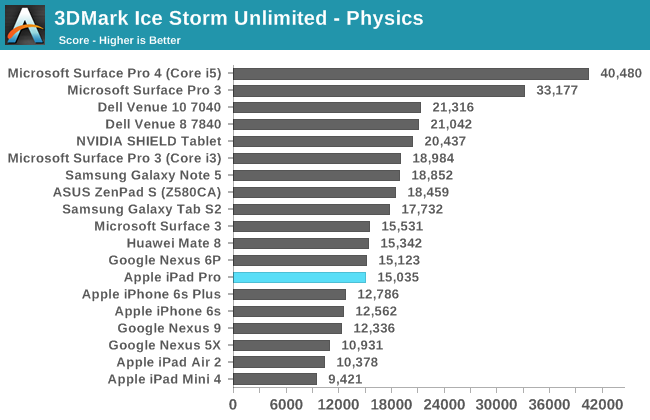
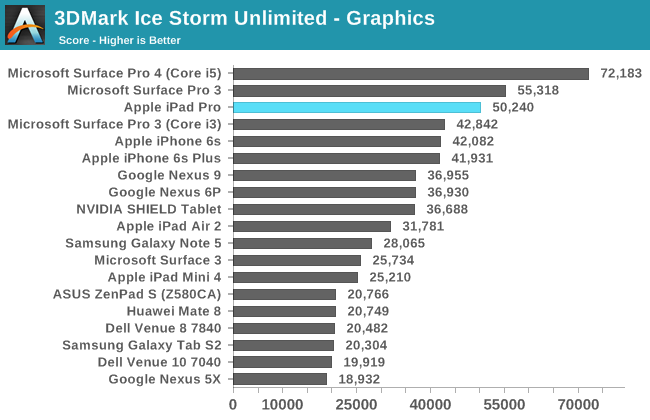
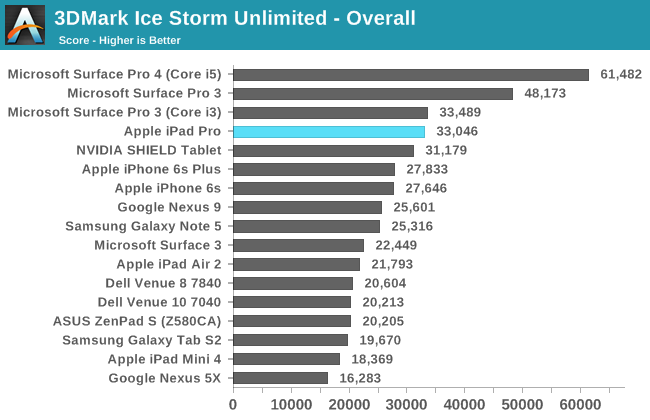
The iPad Pro manages to maintain superiority in 3DMark, but we're really starting to see the limitations of this test. The physics test generates non-sequential data structures with memory dependencies, which can penalize devices with lower core count and clock speed, but the workload is able to be spread across multiple cores to exploit TLP, which benefits devices with more real cores, or virtual ones (hyperthreading). We also see that the graphics test isn't really scaling well at this point as it's just too light to take advantage of the full potential of the A9X GPU. This likely also explains why the iPad Pro isn't closer to the Surface Pro 4 in performance on this benchmark, given what we know about A9X's GPU.
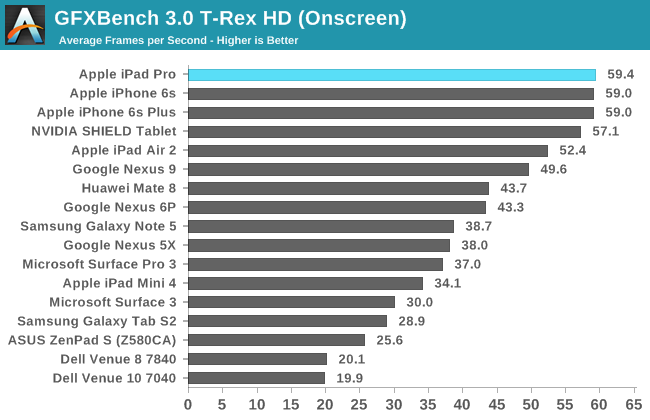
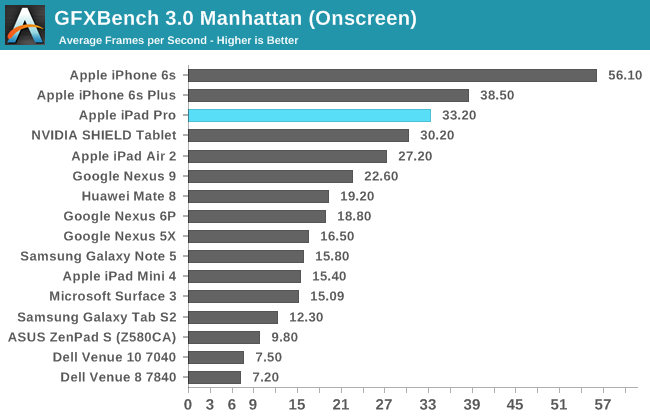

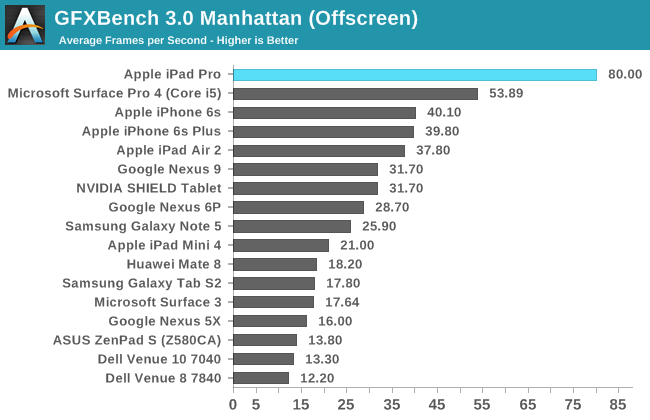
In GFXBench we can see the major benefits that really come with the larger GPU. It's pretty obvious here that clock speeds are basically identical when comparing the A9 GPU and A9X GPU as the scaling is almost perfectly double. In this benchmark the iPad Pro quite handily beats the Surface Pro 4, but it's important to keep in mind that the Surface Pro 4 is running a higher level of precision and that the iPad Pro is running OpenGL ES rather than OpenGL in this test, so it isn't strictly apples-to-apples (nor is such a thing truly possible at this time). Overall though the GPU of the iPad Pro is incredibly impressive, and I doubt that anyone will really have issues with gaming performance on this device.
NAND Performance
At this point it’s pretty well understood that storage performance can often be a gating factor in performance. Although caching is an amazingly effective method of hiding memory latency, for the first hit it’s mandatory to miss the cache unless you’ve managed to prefetch the data in question. The other issue where storage performance becomes obvious are cases where it’s necessary to commit data to storage first. Some cases where this is going to be obvious is app installation or iCloud restores, especially when network performance is at the point where installation can actually be gated by writing to disk rather than downloading from the network.
In the case of the iPad Pro, Apple claims that they’ve implemented a storage controller comparable to some desktop SSDs. It turns out that this controller is a familiar one, as the storage controller identifies itself as the APPLE SSD AP0128K in the case of this review unit. It turns out that everything about this SSD is identical to what we saw in the iPhone 6s as well, down the use of Hynix for at least one of the NAND vendors and the hybrid SLC/TLC architecture discussed in previous articles. In order to test how this storage solution performs we once again use Eric Patno’s StorageBench, which provides a rough analogue to AndroBench 3.6.
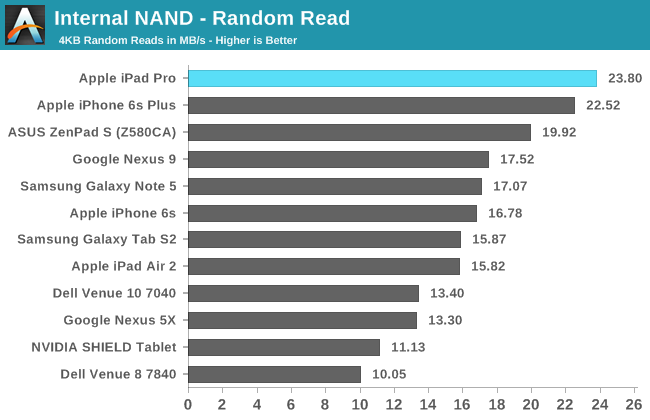

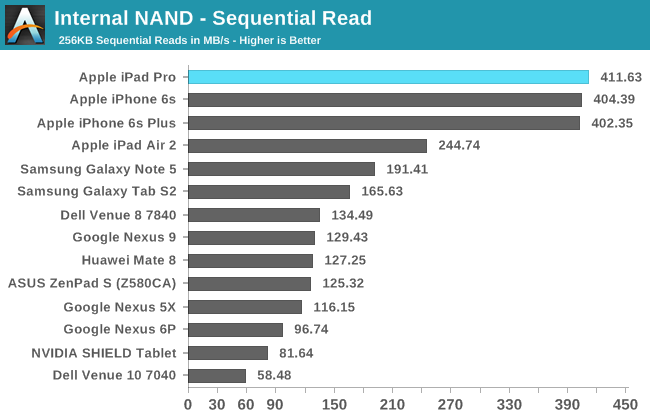
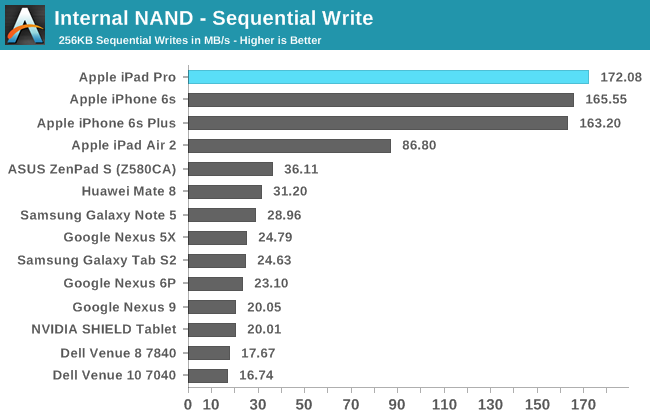
It turns out that in this test, performance is basically identical to the iPhone 6s. This isn’t quite the equal of something like the Surface Pro 4’s PM951 SSD, which has the advantage of more NAND dies working in parallel, but given that the iPad Pro PCB size isn’t going to be anywhere near that of the Surface Pro 4 it’s likely that this is a concession to gain better battery life. I definitely wonder what performance would be like relative to a Surface Pro 4 if the iPad Pro had a 512GB SKU, but given that the iPad Pro tops out at 128GB this isn’t really a question with a relevant answer.










408 Comments
View All Comments
Jumangi - Saturday, January 30, 2016 - link
Why wouldn't it? It's in a similar price range and is pushed as a "professional" device for use in business.eNT1TY - Wednesday, January 27, 2016 - link
I only owned the device for 3 weeks before returning it but i must say the apple pencil was fantastic. For my needs the ipad pro wasn't particularly any more "pro" than an ipad air 2 but combined with the pencil comes pretty damn close to being something special for graphics work though you are ultimately still not going to finalize/complete any work on it but you can get a hell of a start. File management sucks, like going around your ass to get to your elbow.But back to the pencil, it is amazing when the app takes full advantage. Adobe sketch is not that great even pen optimized but procreate is a different beast. The pencil has no perceptible lag, something even my wacom pro pen on my cintiq 27qhd can't claim and has more accurate angle recognition and doesn't distort drawing on the edges of the screen. Procreated is the real deal and much better at exporting a complex psd's than adobe's own. Adobe Draw fared a bit better than Sketch as far as responsiveness to pencil. uMake is no solidworks and is too basic and weak for a $15 monthly subsciption app but it felt intuitive with the pencil.
I can wait for the pro 2, it will have a mature selection of apps by then and hopefully that newer version of ios will have better file management solutions. Man apple just needs to make a pencil compatible imac as well and stick it to wacom.
jjpcat@hotmail.com - Wednesday, January 27, 2016 - link
It's interesting to compare A9X and Intel M. I am wondering if Apple has any data to back up its claim that A9X is faster than 80% of portable PCs released in the past year.I would like to see more info:
1. Die size: A9X is 147 mm^2 while is 99 mm^2. So Intel may have an advantage here. But I am not sure if we can come to the conclusion that Intel has a cost advantage.
2. Where's the GPU comparison?
3. I don't trust Intel's TDP claim. It's better to include that in your power consumption test.
Constructor - Wednesday, January 27, 2016 - link
1. Processes are different, as are the respective chip designs on the whole (including what's on the chips), so the physical size doesn't say that much.2. In other tests. The A9X looks quite good in these.
3. TDP doesn't say much about actual consumption in real life anyway. It only says how much heat the cooling solution will have to move away at maximum. Battery usage can still vary substantially even at the same nominal TDP if – for instance – one of the chips can do "regular work" at lower power than the other. TDP comes only really into play when the chips are ramping up to maximum performance and try to stay there.
The CPU comparison part of this test is pretty sketchy. Not necessarily wrong, but likely disregarding crucial influences on the particular benchmarks (vectorization by the compilers being part of it).
rightbrain - Friday, January 29, 2016 - link
Another useful comparison would be die size, since it gives a rough but real cost comparison.Constructor - Friday, January 29, 2016 - link
Not really, because densities are different and so are yields as well as process and SoC development costs.ads2015 - Monday, February 1, 2016 - link
Apple's SPEC06 option "-O3 -FLTO" not "-Ofast". All cases are okhttp://llvm.org/devmtg/2015-10/slides/Gerolf-Perfo...
and llvm has 30+% performance headroom for SPEC06.
Delton Esteves - Wednesday, February 3, 2016 - link
Biased review.Ipad Pro
No usb ports
No display port or HDMI
No memory card
No Kickstand
No pen included
Keyboard:
Is expensive
No backlit
No trackpad
No function keys
There is no place to rest the hand
Very complicated to set up
Ipad Pro runs a Mobile OS
Summing up, Ipad Pro cannot be considered a Pro device, so, stop being a Fanboy. Surface Pro 4 wins
Crisisis - Thursday, February 4, 2016 - link
Just.in.the.same.paragraph: "stop being a Fanboy" and "Surface Pro 4 wins". A new definition of irony.Delton Esteves - Wednesday, February 10, 2016 - link
"A new definition of irony". why do you think Ipad Pro is better? Justify?